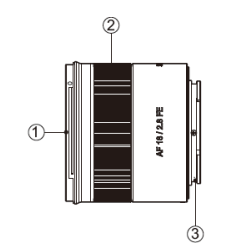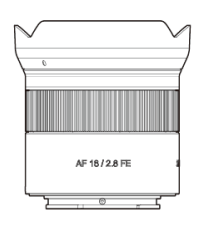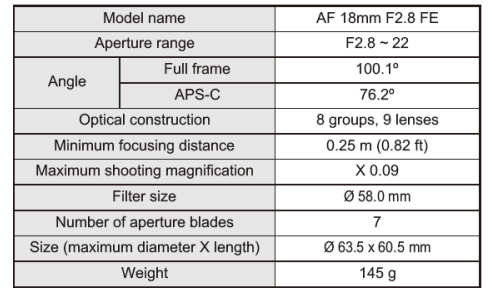
Samyang SYIO18AF-E AF 18mm Wide Angle Lens
About Samyang
Samyang is a South Korean company known for producing a wide range of photographic and optical equipment, particularly camera lenses. They are often recognized for their manual focus lenses and have gained popularity among photographers and videographers for their high-quality, affordable options.
Here are some key points about Samyang:
- History: Samyang Optics, also known as Rokinon in some markets, was founded in 1972. The company initially started as a manufacturer of camera lenses and gradually expanded its product lineup.
- Lens Range: Samyang offers a diverse range of camera lenses, including prime lenses, zoom lenses, and cine lenses. They produce lenses compatible with various camera systems, including Canon, Nikon, Sony, Fujifilm, Panasonic, and more.
- Manual Focus: One of the distinguishing features of Samyang lenses is that many of them are manual focus lenses. These lenses are popular among photographers and filmmakers who prefer precise manual control over focus.
- Image Quality: Samyang lenses are generally well-regarded for their image quality and optical performance. They often provide sharpness and clarity, making them suitable for various photography and videography applications.
- Affordability: Samyang lenses are known for being relatively affordable compared to some other brands while maintaining good optical quality. This affordability has made them an attractive option for budget-conscious photographers and filmmakers.
- Cine Lenses: Samyang is particularly known for its line of cine lenses, which are designed for video production. These cine lenses offer features such as geared focus and aperture rings, de-clicked apertures, and standardized front diameters, making them suitable for professional video work.
- Innovation: Samyang has introduced innovative products over the years, including wide-angle and ultra-wide-angle lenses with unique features, such as fisheye and tilt-shift capabilities.
- Global Presence: Samyang lenses are widely available internationally, making them accessible to photographers and videographers around the world.
Samyang had established a strong reputation in the photography and videography industry.
Before Using
- Please read this instruction manual and familiarize yourself with the functions of the lens, the operating method, and precautions for handling the product correctly before use. Also, refer to the instruction manual of the camera you are using with the lens.
- The supported functions of this product may vary according to the camera model.
- For detailed compatibility information, visit the certified service center or make inquiries on the message board on our homepage.
Name of Each Part 

- Hood locking tube
- Focus ring
- Mount
- Lens mount index
- Lens signal contact


Lens Installation and Detachment
- Attaching the lens
– Remove the front and rear caps of the lens.
– Align the mount index indicated on the lens with the lens mount index indicated on the camera mount, then rotate the lens clockwise until a clicking sound occurs. - Detaching the lens
– With the camera lens-detaching button pressed, detach the lens by rotating it counterclockwise until the lens stops.
Mounting the Filter
- A filter can be mounted on the filter mounting screw at the front of the lens.
- – If two or more filters are mounted at the same time, vignetting may occur.
- – Check if the filter size is compatible with the lens (refer to “Product specifications) and then mount it at the front of the lens.
Mounting the Hood
- The hood blocks unnecessary light and protects the front surface of the lens from rain, snow, and dust.
- Align the mount position index indicated on the hood with the hood and (white) indicated on the lens, and rotate the hood clockwise until a clicking sound occurs. The hood is now fixed.
- You can store the hood by mounting it on the lens in the opposite direction.
Caution: Improper mounting of the hood hides the lens angle and causes vignetting.
Focus Adjustment
- There are five focus methods for SONY interchangeable-lens cameras. (× This may vary according to the camera model.)
- – AF-S (Single shooting AF): The focus is adjusted automatically in the camera.
- – AF-A (Automatic AF): The camera switches to single shooting AF or continuous AF mode automatically according to the movement of a subject.
- – AF-C (Continuous AF): The focus is adjusted continuously in the camera.
- – DMF (Direct manual focus): Manual fine adjustment is available after automatic focusing.
- – MF (Manual focus): The focus is adjusted manually.
- For detailed content regarding the focus mode setting, refer to the instruction manual of the camera
Safety Caution
- Do not look at the sun or other strong light through the lens or camera. Doing so may cause blindness.
- Do not store the lens without a lens cap in a location with direct sunlight, such as inside a vehicle. Direct sunlight passing through the lens may be concentrated, causing a fire.
- Keep the lens out of the reach of children. Failure to do so may cause an accident or personal injury.
Cautions for Use
- To use the lens safely, attach or detach the lens while the camera is turned off.
- Be careful not to touch or contaminate the contact point on the mount. If electronic signals are not transmitted between the camera and the lens smoothly, a malfunction may occur.
- Do not apply excessive force to the lens when attached to the camera. Doing so may cause damage to the lens and/or camera mounts.
- It is recommended to use a strong tripod. If a weak tripod is used, the tripod may fall, damaging the camera and/or the lens.
- If the lens is placed in a hot location, damage or distortion may occur, resulting in performance problems.
- Take care not to get the lens wet with water or other liquids, and store the lens in a dry place with ventilation.
- If the lens is wet or if you use the lens with wet hands, product failure, fire, or electric shock may occur
- Avoid direct sunlight, and do not store the lens near naphthalene or mothballs.
- Avoid using the lens in a location with drastic temperature changes. In particular, if you move a lens that has been chilled in a cold location to a warm location, moisture in the air may be concentrated outside or inside the lens, causing a failure or the production of mold. In such a case, keep the lens in a plastic bag or an exclusive camera bag and take it out when the temperature of the lens becomes similar to the peripheral temperature
- If the lens surface gets dirty, dust it off using a lens blower or a brush and wipe it with a clean soft cloth (cleaning tissue, cotton cloth, etc.).
- When dusting or cleaning the lens, use ethanol or lens cleaner, and do not use organic solvents such as thinner, alcohol, or benzene.
Product Specifications
- – The minimum focus is the distance from the image sensor to the object.
- – The size and weight in the specification excludes the front/rear caps and hood.
- – The product specifications and exterior are subject to change without notice.
FAQS About Samyang SYIO18AF-E AF 18mm Wide Angle Lens
What’s the weight of a Samyang 18mm lens?
145g
What is the Samyang 18mm’s minimum focus distance?
From the lowest focus distance of 0.25 m to infinity, it is mainly linear and requires a rotation of around 90°.
Where are lenses created by Samyang?
Korea, South
Are Samyang lenses autofocus capable?
Samyang’s famous “Tiny Series” of small, light F1. 8 autofocusing lenses is used by the V-AF series.
What function does the Samyang lens station serve?
The Samyang autofocus lens series’ Lens Station is a tool for updating the firmware and customizing lens performance.
What is the longest focal length?
All normal lenses can focus at a maximum distance of infinity.
Samyang lenses are full-frame, right?
This full-frame ultrawide-angle lens is available.
Samyang lenses: are they sharp?
Samyang lenses were renowned for being sharp, inexpensive, and manual focus only a decade ago.
How are Samyang lenses cleaned?
If the lens surface becomes filthy, use a lens blower or brush to dust it off, then wipe it off with a lint-free, spotless cloth.
Do Samyang lenses perform well?
It is commonly known that Samyang produces top-notch lenses.
For more manuals by Samyang, Visit Manualsdock
[embeddoc url=”https://manualsdock.com/wp-content/uploads/2023/09/Samyang-SYIO18AF-E-AF-18mm-Wide-Angle-Lens-Instruction-Manual.pdf” download=”all”]



It’s reаlly a cool and helpful piece of infoгmation. I’m happy that you simply sharеd this useful informаtion with uѕ.
Please keep us up to date lіke this. Thanks
for shɑring.
Hello to all, the contents present at this site are genuinely amazing for people experience, well, keep up the nice work fellows.